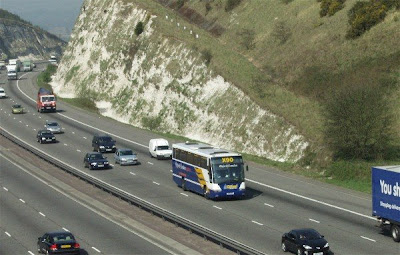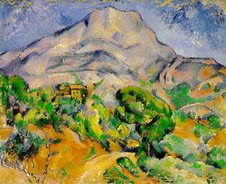
David Llewellyn was enthusing on his most recent post about Oxfordshire - the delectable English county that was flashing past his train window, en route from London to Cardiff. He didn't say whether he and it were old friends from the past, but one assumes that they were.
I too am a landscape junkie. And what better way is there to see an unfamiliar stretch of countryside for the first time than by train ? Once clear of the towns, the view from a carriage window is unlikely to be cluttered with filling stations and the like that tend to obtruct or interrupt the view from a highway. And its hard, in any case, to take in the scenery if one is driving.
Jane and I were once on an intercity train to Devon, or maybe Cornwall, and went through a gorgeous stretch of Somerset countryside. I just managed to glimpse some station names - Bruton and Castle Cary. For weeks afterwards I ached to go back and visit. When we went finally to the ticket office at Paddington, the guy behind the little window was delighted when I said where we wanted to go - he being a fellow connoisseur of Britain's best hopping off points. In passing, I'd mention that the chap was a real character, who used to do entertaining albeit somewhat over-embroidered train announcements over the tannoy in his uncompromising pre-1960s BBC Home Service accent .
I risked missing my commuter train regularly, just listening to that throwback accent, with its plumminess and his jolly if somewhat forced witticisms . Give some people a microphone (or internet soapbox ?) and there's no stopping them ....
Even if Bruton was not the paradise that it seemed from that first subliminal acquaintance, our day trip there was the fulfilment of a totally mad obsession - as work colleagues were not slow to remark at the time.
So it was heartening years later to read Bill Bryson doing exactly the same thing with Retford in Lincolnshire - whizzing past it on the train, having an instant love-affair, and deciding he just had to return one day and give the place a closer look !
But on another occasion it all went pear-shaped when he decided on impulse that Barnstaple would be a characterful backwater of maritime English tradition, haunted by the ghosts of English seafarers. But on finally gettting there, after lengthy delays on the line, it was to find that the relative anonymity of this N. Devon port town was perhaps not totally undeserved.
I think he put it somewhat more pithily, as is his wont when concluding a chapter.
Bryson, by the way, is one of my favourite authors. He just has that way with words. But I was given a book of his for Christmas, about his childhood days (The Life and Times of the Thunderbolt Kid). Did you know his father had been a top-rate sport journalist, with some memorable prose to his credit ? And the image of bumbling laid-back Uncle Bill takes a bit of knock too, thanks to some candid writing. Did you know that he had fallen in with the wrong crowd for a time, and was lucky not to have a criminal record ?
Anyway, to return to David's post, I too enthuse over the subtle delights of Oxfordshire, having lived for many years in neighbouring Bucks, and hiked, cycled, canoed, motored and even hot-air ballooned over substantial tracts of both counties. Here's my comment (still the only one up - I hope I have not scared everyone away with a tour de force of local knowledge):
"For those with a car in the London area, the best approach to the Oxfordshire plain is via the M40, just beyond High Wycombe and Stokenchurch.
The motorway makes a dramatic exit from Bucks to Oxfordshire down a steep cutting through the chalk escarpment. It's the scene that one sees in that opening tracking shot of the "Vicar of Dibley".
For those who wish to tarry and take in more of the view, there's a superb panorama to be had at the Aston Rowant nature reserve on the side of Beacon Hill.
Through binoculars one can follow the line of the motorway around the side of Oxford and beyond.
Oxford itself is not visible, lying as it does in a hollow, but with the eye of faith one can just about make out the tips of those dreaming spires.
It's then about 10 miles to Boars Hill on the outskirts of Oxford, home in the past to many famous poets.
Sadly the view from Sir Arthur Evans' home-made vantage point (Jarn Mound) is now largely obstructed by conifers that have sprung up in nearby gardens, a sad fact of modern life that gets a mention in Wikipedia. http://en.wikipedia.org/wiki/Boars_Hill
But if one one wanders around, there's a view back across the plain to that prominent landmark, the Stokenchurch telecommunications tower("Pots and Pans" as we call it).
And it's an eery sight to see, in midsummer, again through binoculars, the HGVs negotiating the Stokenchurch Gap through a heat haze. Think of that flapping, broken-up image of Omar Sharif emerging from the desert in Lawrence of Arabia and you will know what I mean.
Here where I live in Antibes, I can see HGVs through binoculars on an elevated stretch of autostrada in neighbouring Italy, between Bordighera and San Remo - a distance of some 40 miles as the crow flies !" Link to earlier post
I tried to find the opening clip of "Vicar of Dibley" on YouTube etc, but without success, so the still of that Stokenchurch Gap ( aka Chiltern Cutting) is at the top instead.

It wasn't too difficult to locate pictures of the "Pots and Pans" landmark (picture above)








